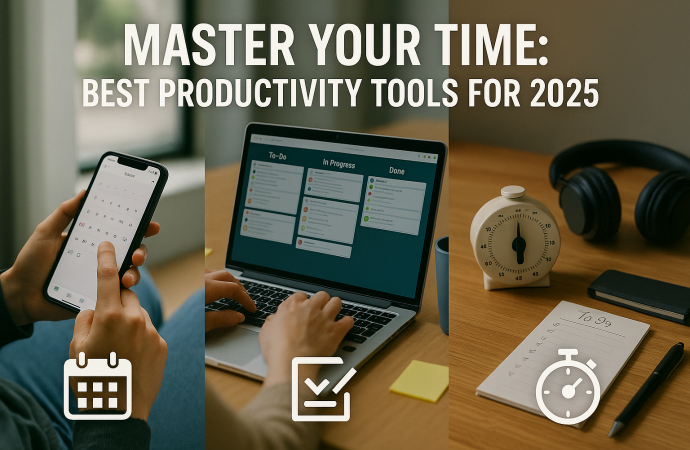Introduction Every year brings a new wave of “must‑have” apps that promise to tame your to‑do list. Yet most people still feel that days race by faster than ever. In 2025, genuine time mastery depends on two things: picking a lean set of high‑impact tools and wiring them into habits you will actually keep. The
Introduction
Every year brings a new wave of “must‑have” apps that promise to tame your to‑do list. Yet most people still feel that days race by faster than ever. In 2025, genuine time mastery depends on two things: picking a lean set of high‑impact tools and wiring them into habits you will actually keep.
The good news? Recent leaps in artificial intelligence, cross‑platform sync, and voice processing have produced a shortlist of apps that truly lighten cognitive load. Whether you juggle remote meetings, side hustles, or study sessions, the bold best productivity tools 2025 reviewed here can help you work with clarity instead of chaos.
What Is This and That? Quick Glossary for 2025 Tools
| Term | Simple Meaning | Relevance |
|---|---|---|
| LLM micro‑agent | Tiny AI model running locally | Processes tasks offline, saving battery and data |
| Focus pulse | Timed deep‑work session plus micro‑break | Used by timers to guard cognition |
| Smart capture | Instant voice or photo note that auto‑tags context | Prevents idea loss |
| Zero‑copy sync | Data shared by reference, not duplicate files | Speeds collaboration |
| Adaptive nudging | Notification timing tuned to past behavior | Raises habit stickiness |
Knowing these terms helps you parse marketing blurbs and select the right stack.
Core Categories and Their Stand‑Out Apps

Image by: Yandex.com
2. Universal Task Hubs
ThingsFlow Nexus serves macOS, Windows, web, and Android, with zero‑copy sync across devices. Natural‑language capture (“Finish client deck by Friday, urgent”) auto‑assigns priority and deadline. Projects nest Kanban or list views without feature bloat.
3. Contextual Note‑Taking
Obsidian Atlas builds on plain‑text Markdown yet layers graph AI. Drop a voice snippet, and Atlas transcribes, links to related notes, and creates flash cards. Ideal for students or researchers who drown in sources.
4. Focus and Distraction Management
DeepWave Focus uses sonar‑style Doppler signals from laptop speakers to detect fidget patterns that often precede distraction.
5. Meeting Capture and Action Extraction
OtterPilot Plus 2025 integrates with Zoom, Teams, and Meet. It records, transcribes, and—here’s the upgrade—classifies decisions vs. follow‑ups, then ships assigned tasks to your planner. Edge processing redacts sensitive data before cloud sync.
6. Automation and Integration
UnifyFlow Studio replaces Zapier for many users. Drag‑and‑drop nodes let you build rules like “When a Trello card moves to ‘Done,’ append a daily digest note and archive related Slack channel.” Free tier handles 10 000 actions monthly.
7. Personal Knowledge Management (PKM)
MemGraph Quantum creates a mind‑map of everything you read or write. Ask, “What did I learn about carbon credits last March?” and it surfaces notes, PDF highlights, and emails in one scroll. Useful for consultants dealing with scattered expertise pockets.
Task Management Apps: Organize Your Workflow
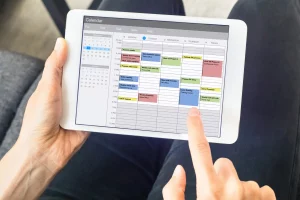
Image by: Yandex.com
A solid task management app is the backbone of modern productivity. These platforms let you create projects, assign tasks, set due dates, and track progress—all in one place. Look for features like kanban boards, Gantt charts, and recurring tasks to match your preferred style.
Popular tools in 2025 emphasize customization. You might use color‑coded labels, custom fields, or templated workflows for common projects. Mobile apps keep you in sync on the go, letting you tick off completed tasks from your phone.
Focus Apps: Block Distractions
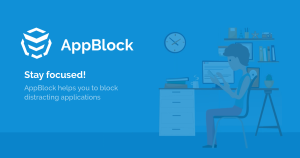
Image by: Yandex.com
In a world of constant pings, focus is a rare skill. Focus apps help by muting distractions and guiding your work blocks. Some use the Pomodoro method: work for 25 minutes, then take a five‑minute break. Others let you blacklist distracting sites during set hours. You can schedule focus windows on your calendar, and the app enforces them.
During these windows, you get only urgent notifications. Some apps brace your phone screen with a timer that blocks new apps. Pair these apps with white‑noise or ambient sound playlists to heighten concentration. When you commit to a focus session, you can achieve deep work—those hours when you produce your best ideas and output. Over time, these sessions become a habit. You squeeze more out of each day while avoiding burnout from endless task switching.
Table—Best‑in‑Class Tools at a Glance
| Category | Tool | Platform | Notable Feature | Cost* |
|---|---|---|---|---|
| Time‑Blocking Planner | Reclaim AI 2.0 | Web, iOS, Android | Energy‑curve auto‑scheduling | $10/mo |
| Task Hub | ThingsFlow Nexus | Cross‑device | Zero‑copy instant sync | $8/mo |
| Note‑Taking | Obsidian Atlas | Desktop, Mobile | AI link + flash‑card builder | $5/mo |
| Focus Timer | DeepWave Focus | macOS, Windows | Doppler distraction sensor | $4/mo |
| Meeting Captures | OtterPilot Plus | Web | Edge action extraction | $15/mo |
| Integrations | UnifyFlow Studio | Cloud | 200+ app nodes, free tier | $0–$20 |
| PKM Graph | MemGraph Quantum | Web | Semantic search across data | $12/mo |
| Energy Tracker | Oura Ring G4 | Wearable | HRV push to planners | $6/mo after hardware |
*Prices reflect personal plans; team tiers cost more.
Building a Lean Productivity Stack: Step‑by‑Step
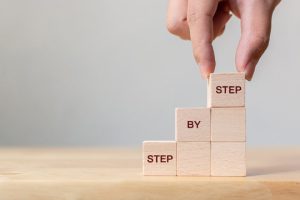
Image by: Yandex.com
- Audit Your Pain Points. Log a typical week. Are tasks forgotten? Meetings un‑actioned? Focus shattered? This guides tool choice.
- Start with a Planner, Add Slowly. Time blockers become the spine. Integrate tasks next, then notes, avoiding app overwhelm.
- Set Up Automations for Low‑Value Tasks. Use UnifyFlow to file invoices, rename downloads, and post daily summaries.
- Guard Focus Windows. Pair DeepWave Focus with website blockers. Keep sessions 50–90 minutes to match ultradian rhythms.
- Review Weekly. Every Friday, archive done tasks, tag key notes, and clean pipelines. Tiny housekeeping keeps chaos away.
Advanced Tips for Power Users

Image by: Yandex.com
- Voice‑First Capture: Configure phone back‑tap to open OtterPilot and dictate tasks while walking.
- Nested Time Blocks: Use secondary color codes for energy‑dependent tasks (green = deep creative; yellow = admin).
- Automated Goal Check‑Ins: Script UnifyFlow to send you a weekly email showing time spent per project vs. OKRs.
- Parallel Reading Queue: Link Obsidian highlights to MemGraph nodes labeled “Awaiting Synthesis,” ensuring new info feeds output.
These moves upgrade tools from helpers to silent collaborators.
Balancing Automation with Mindful Control
Beware tool overload. Every notification is a micro‑tax on attention. Lean on adaptive nudging, but schedule regular “manual override” slots—perhaps Sunday mornings—to reflect on goals away from screens. Productivity is freedom to focus on what matters, not unending data pings.
Pitfalls and How to Avoid Them
| Trap | Symptom | Fix |
|---|---|---|
| Shiny‑App Syndrome | Switching tools monthly | Commit to a 90‑day stack experiment |
| Over‑automation | Confusion about where data lives | Map workflows visually; consolidate |
| Notification Noise | Alerts every few minutes | Cluster non‑urgent digests twice daily |
| Poor Review Habit | Tasks linger, notes rot | Calendar a 30‑minute weekly review block |
Consistent reviews trump new features.
Real‑World Success Story
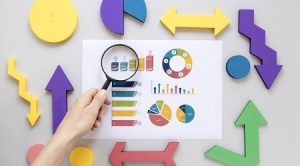
Image by: Yandex.com
Marisol, a freelance UX designer, juggled five clients and night classes. After adopting Reclaim AI, DeepWave Focus, and OtterPilot, her billable hours rose 20 % while working two fewer hours per week. Key changes: automatic scheduling around energy peaks (late mornings), meeting actions flowing straight into her task list, and distraction pulses cutting social scrolling by 30 minutes daily.
Future Outlook—Beyond 2025
Expect:
- Predictive Collaboration: Tools forecast who you should loop into a project based on past outcomes.
- Spatial Productivity: VR workrooms integrate task hubs as floating widgets, merging focus mode with immersive calm.
Staying adaptable is the best long‑term strategy.
Conclusion
The best productivity tools 2025—from AI‑driven planners and contextual note apps to focus sensors and integration studios—share a goal: freeing mental bandwidth for work that matters. Choose a lean stack anchored by a smart calendar, link tasks and notes through open standards, automate trivial chores, and protect deep‑work blocks with seamless focus tech. Review systems weekly and prune alerts ruthlessly. Master these habits, and time becomes ally, not adversary—giving you space for bold goals and balanced living.
Call‑to‑Action
Select one tool from this guide—perhaps Reclaim AI or ThingsFlow Nexus—and commit to a 14‑day trial. Measure your focus hours and task completion rate. Share the results with #Productivity2025 to inspire peers and refine your system.

